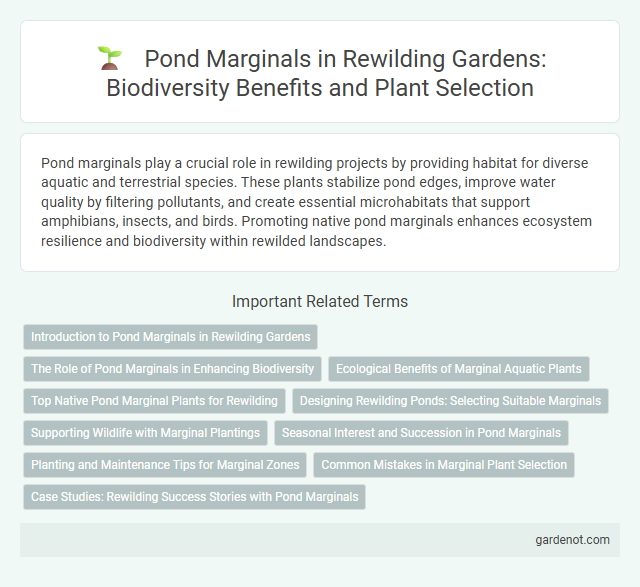Pond marginals play a crucial role in rewilding projects by providing habitat for diverse aquatic and terrestrial species. These plants stabilize pond edges, improve water quality by filtering pollutants, and create essential microhabitats that support amphibians, insects, and birds. Promoting native pond marginals enhances ecosystem resilience and biodiversity within rewilded landscapes.
Introduction to Pond Marginals in Rewilding Gardens
Pond marginals play a vital role in rewilding gardens by supporting biodiversity and maintaining aquatic ecosystem health. These plants, such as water mint and marsh marigold, provide habitat for insects, amphibians, and birds while improving water quality through natural filtration. Incorporating native pond marginal species enhances ecological balance and promotes a sustainable, self-regulating garden environment.
The Role of Pond Marginals in Enhancing Biodiversity
Pond marginals play a crucial role in enhancing biodiversity by providing essential habitat for amphibians, insects, and aquatic plants that support local ecosystems. These vegetation zones filter pollutants, stabilize pond banks, and create microhabitats that increase species richness and ecological resilience. Integrating diverse native pond marginal plants such as reeds, rushes, and sedges promotes a balanced aquatic environment that sustains a wide range of wildlife in rewilding projects.
Ecological Benefits of Marginal Aquatic Plants
Pond marginals, such as reeds, rushes, and sedges, play a critical role in enhancing aquatic ecosystems by stabilizing pond banks and reducing erosion. These marginal aquatic plants improve water quality through nutrient uptake, effectively filtering pollutants and preventing algal blooms. They provide essential habitat and breeding grounds for diverse wildlife, including amphibians, insects, and birds, thus supporting biodiversity and ecological resilience.
Top Native Pond Marginal Plants for Rewilding
Top native pond marginal plants for rewilding include species such as Iris pseudacorus (yellow flag iris), Schoenoplectus lacustris (common club-rush), and Carex acutiformis (lesser pond-sedge) known for their ecological benefits in wetland restoration. These plants provide essential habitat for amphibians, insects, and birds, while improving water quality through natural filtration and erosion control. Integrating diverse native pond marginals supports biodiversity by creating complex food webs and stabilizing pond ecosystems.
Designing Rewilding Ponds: Selecting Suitable Marginals
Selecting suitable pond marginals is essential in designing rewilding ponds to enhance biodiversity and ecosystem stability. Native species like reed canary grass, water mint, and marsh marigold provide critical habitat for amphibians, insects, and birds while improving water quality through natural filtration. Incorporating diverse marginal plants supports resilient pond edges, promotes natural succession, and encourages wildlife colonization in rewilded landscapes.
Supporting Wildlife with Marginal Plantings
Pond marginals create essential habitats by stabilizing shorelines and providing shelter for amphibians, insects, and bird species. Planting native marginal vegetation like reeds, sedges, and rushes enhances biodiversity, promoting natural food sources and breeding grounds. These wetland buffer zones improve water quality by filtering pollutants, supporting aquatic ecosystems within rewilding projects.
Seasonal Interest and Succession in Pond Marginals
Pond marginals provide vital seasonal interest through dynamic growth cycles and flowering patterns that enhance wetland ecosystems from spring to autumn. Succession in pond marginals involves gradual species replacement and habitat shifts, promoting biodiversity by supporting amphibians, insects, and aquatic plants over time. Managing these areas with native, multi-seasonal species ensures vibrant, ecologically productive pond edges throughout the year.
Planting and Maintenance Tips for Marginal Zones
Pond marginals thrive when planted deeply in nutrient-rich, well-drained soil at the water's edge, ensuring roots remain submerged but crowns stay above water to prevent rot. Regular maintenance involves removing dead foliage to promote healthy growth and prevent algae buildup, while monitoring water levels supports optimal hydration without waterlogging. Selecting native marginal plants such as Iris pseudacorus, Carex spp., and Glyceria maxima enhances biodiversity and resilience in rewilded aquatic ecosystems.
Common Mistakes in Marginal Plant Selection
Selecting pond marginals often involves common mistakes such as choosing invasive species that disrupt local ecosystems or planting species unsuited to the specific water depth and soil conditions. Overlooking compatibility with native wildlife can reduce biodiversity and hinder rewilding success. Proper identification of native, non-invasive plants with appropriate sun and moisture requirements ensures healthier pond margins and supports ecosystem restoration.
Case Studies: Rewilding Success Stories with Pond Marginals
Case studies on rewilding with pond marginals highlight significant ecological recovery through native plant reintroduction such as water mint (Mentha aquatica) and yellow flag iris (Iris pseudacorus). These species stabilize pond banks, improve water quality, and provide essential habitat for amphibians, dragonflies, and aquatic invertebrates. Projects in the UK and Europe demonstrate increased biodiversity and enhanced ecosystem resilience linked directly to targeted pond marginal rewilding efforts.
Pond marginals Infographic

 gardenot.com
gardenot.com